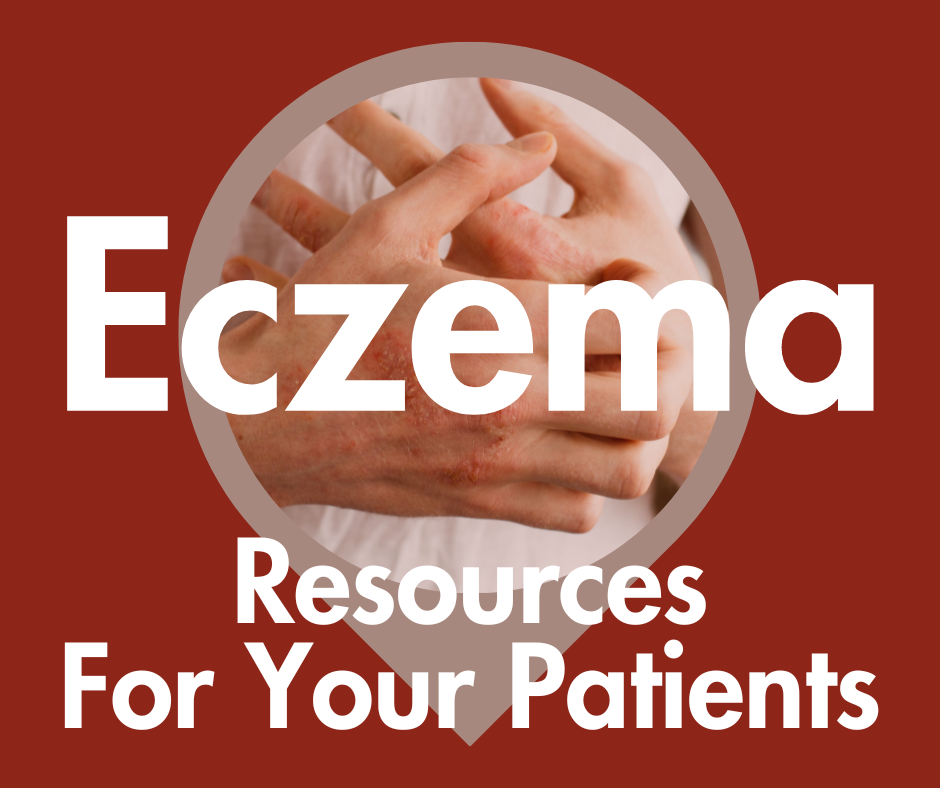- Acne
- Actinic Keratosis
- Aesthetics
- Alopecia
- Atopic Dermatitis
- Buy-and-Bill
- COVID-19
- Case-Based Roundtable
- Chronic Hand Eczema
- Drug Watch
- Eczema
- General Dermatology
- Hidradenitis Suppurativa
- Melasma
- NP and PA
- Pediatric Dermatology
- Pigmentary Disorders
- Practice Management
- Precision Medicine and Biologics
- Prurigo Nodularis
- Psoriasis
- Psoriatic Arthritis
- Rare Disease
- Rosacea
- Skin Cancer
- Vitiligo
- Wound Care
News
Article
Eczema Resources for Your Patients: Monthly Recap
Author(s):
Review the full list of eczema resources for your patients shared during National Eczema Awareness Month.

Throughout the month of October, Dermatology Times collected various eczema resources that you can share with your patients during National Eczema Awareness Month. As a chronic skin condition that affects 1 in 10 people, it’s crucial to provide patients with the resources they need to encourage proper care and education.1
Below is a full list of eczema resources shared throughout the month and recommended by clinicians.
Week 1
1) EczemaWise – National Eczema Association
The National Eczema Association’s EczemaWise app helps patients keep track of their triggers, symptoms and, and treatments. With physician-provided science and input, the app can then reveal trends and highlights in patients’ flares to share with their physician. Data recording includes skin, itch, pain, sleep, stress, treatments, triggers, diet, and weather. Patients are also able to print their health data to bring to their next appointment.
2) Asthma and Allergy Foundation of America (AAFA)
The AAFA provides a comprehensive guideline of eczema and its most common subtype, atopic dermatitis. Common triggers of eczema listed by the AAFA include allergens, soaps and household cleaners, metals such as nickel, rubber products, perfumes and other fragrances, dyes, and formaldehyde. To prepare patients for their appointments, the AAFA lists possible events that may have triggered a flare, including going hiking, wearing a new necklace, or using a new laundry detergent.
The “Atopic Dermatitis: A Guide for Your Family” booklet from the Boston Children’s Hospital is a 40-page resource for patients that includes in-depth chapters on understanding, treating, and managing atopic dermatitis. Specific topics covered include recommended moisturizers, fighting infections, managing the itch-scratch cycle, teaching children about skin care, and more.
4) American Academy of Dermatology (AAD)
The AAD’s Eczema Resource Center features a collection of dermatologist-reviewed information and guides. Patients can look through content on types & treatments, childhood eczema, adult eczema, and insider secrets. The unique insider secret page offers informative videos and write-ups with board-certified dermatologists discussing the difference between eczema and psoriasis, relieving severe atopic dermatitis, managing eczema in the summer, how to use moisturizers, and how to avoid nickel reactions.
Week 2
One of the main focuses of the Allergy & Asthma Network’s “Eczema Resources for Patients” page is teaching individuals about eczema and atopic dermatitis in patients with skin of color and how these conditions can present differently among varying skin tones. The Allergy & Asthma Network’s Learning Pathways include educational videos on understanding atopic dermatitis in skin of color, the role of nurses in atopic dermatitis management, shared decision-making in atopic dermatitis, eczema medications for skin of all colors, treating and managing eczema in all skin of colors, and more. There are all free eczema podcasts featuring board-certified allergist Payel Gupta, MD, and Kortney Kwong Hong, an eczema patient.
Eli Lilly’s ECZchanges is a PDF guide for patients to help them discuss their atopic dermatitis with their health care provider. “ECZchanges: Talking About Dermatitis” is designed to help patients have “meaningful conversations” about their atopic dermatitis, as well as to help patients get the best out of their treatment plan to improve their quality of life and lessen their disease burden. The 7-page guide covers symptoms of atopic dermatitis, descriptions of a flare, avoiding triggers, atopic dermatitis in skin of color, developing a patient-practitioner partnership, and living with atopic dermatitis. Patients can also find links and QR codes throughout the guide to interviews with experts in eczema and atopic dermatitis.
“Taking proactive steps to learn more can help you feel confident that you’re doing everything you can for yourself or your child to cope with the disease,” is the clear message of Eczema Exposed. To further promote beneficial conversations between patients and health care providers, Ezema Exposed created 3 guides for patients to take to their next appointment: Infant Caregiver Doctor Discussion Guide (6 mos – 5 yrs); Child Caregivers Doctor Discussion Guide (6 –17 yrs); and Adult Doctor Discussion Guide (18+ yrs). Each guide has sections to fill out about symptoms, quality of life, life activities that are impacted, and observed triggers.
The Eczema Sample store was created by founder Stephanie who has had eczema since she was only a few months old. While trying to find the best products that worked for her sensitive skin, she would waste significant amounts of money on full-size products that did not work for her skin. Now, the Eczema Sample Store provides subscription boxes of sample-sized eczema products to help patients find the best product for their skin. Subscription options from the Eczema Sample store include seasonal eczema boxes, an annual plan, 6-month plan, seasonal plan, individual seasonal boxes for fall, winter, spring, and summer, an eczema awareness month mystery box, a mini mystery sample box, and more.
Week 3
1) Schweiger Dermatology Group
For patients local to a Schweiger Dermatology Group office or for those looking for online resources, numerous dermatology experts are available. On their website, Schweiger Dermatology Group published a “How to Soothe Eczema With 7 Home Remedies” piece for patients. To help treat flares and lessen their symptoms, Schweiger Dermatology Group recommends: consistent moisturizing, shorter and cooler showers, reducing stress levels, humidifying your space, wearing loose fitting clothing, avoiding harsh soaps, and vacuuming dust and pet dander more often.
2) HealthCentral - #EczemaWarriors
An online article published this year on HealthCentral and reviewed by Holly Singletary, MD, featured 6 real-life #EcemaWarriors who shared their eczema journeys and what worked for their skin. Each of the warriors shared their eczema background, flare fixes, and words of wisdom. Tips for managing flares include sea salt or Epsom salt baths, meditation, cutting back gluten and high-histamine foods, Bodewell Anti-Itch Cream and Super Cream, lukewarm showers followed by Aveeno Baby Daily Wash, and red light therapy.
3) Grahams Natural Alternatives
Grahams Natural was founded by Geoff and Shannon Graham after Geoff himself had experienced horrible eczema as a child, and then watched his son develop severe eczema. Geoff and Shannon began mixing various natural ingredients together until they developed their first C+ Eczema and Dermatitis Cream. Then, they learned the cream needed to be paired with a 100% oil formula for best results, and eventually developed their Body and Bath Oil which worked for their son. Now, patients can shop for a variety of eczema products, including for the face and eyelids, scalp relief cream, rosacea cream, and more.
The Eczema Company was founded by a mother who was also watching her child struggle with severe eczema and extreme itching. Jennifer Roberge focused her efforts on healing her son’s skin from within by closely monitoring foods that increased his flares and incorporating supplements into his diet. Now, the Eczema Company provides patients with natural skin care options and gentle clothing to help stop extreme itching.
Week 4
A global network for eczema and atopic dermatitis resources, AltogetherEczema provides patients with descriptions of eczema and its subtypes, self-management tips, available treatment options, how to schedule a physician visit, eczema-related conditions, and more. Additionally, patients interested in sharing their stories with others to promote awareness can upload and share their story directly on the website.
2) Pfizer – Eczema Inside Out Resources
Pfizer created a patient resource center with a discussion guide for people living with eczema, a patient perspective video on shared decision making, an eczema caregiver’s guide, and a collection of frequently asked questions. The downloadable discussion guide can be filled out by patients before their next appointment to help them clearly record their physical symptoms, mental well-being, treatment goals, and more. Additionally, the caregiver's guide can be filled out regarding the patient’s needs and how their caregivers can support them.
3) International Eczema Council
The International Eczema Council is an online hub of eczema content for both clinicians and patients. In the patient portal, patients can participate in an atopic dermatitis virtual program, created in collaboration with Medscape Education. Patients will learn more about the impacts of eczema as well as how to explain their concerns to clinicians. Other resources from the International Eczema Council include understanding eczema, signs of eczema, an explanation of what causes eczema, understanding if there is a “cure” for eczema, and the relationship between eczema and allergies.
4) Global Parents for Eczema Research (GPER)
GPER is a “grassroots, parent-led non-profit organization that advances research and policy changes that lead to better treatments and prevention strategies for moderate to severe eczema in children.” GPER’s core programs include support for eczema caregivers, the Eczema Breakthrough Podcast, patient- and family-centered research, and a global effort to improve eczema care worldwide. GPER’s newest resource for families managing eczema is the Treatment Navigator. The Treatment Navigator highlights treatments currently available or in clinical trials and then categorizes them by topicals, orals, and injectables.
Reference
- October is Eczema Awareness Month. National Eczema Association. Accessed September 25, 2023. https://nationaleczema.org/eczema-awareness-month/
Newsletter
Like what you’re reading? Subscribe to Dermatology Times for weekly updates on therapies, innovations, and real-world practice tips.





